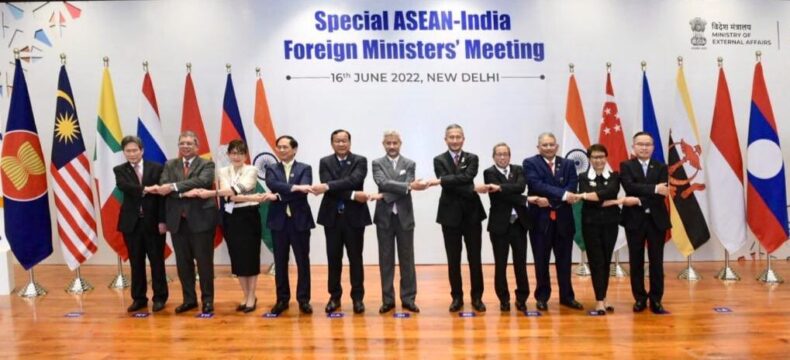In New Delhi (India), ASEAN and India’s foreign ministers met in a special session hosted by the Minister of External Affairs, Dr. S. Jaishankar. India’s support for a strong, united, and prosperous ASEAN was underlined by him during the conference.
India’s Foreign Minister Dr. S Jaishankar has said that India deeply values ASEAN’s centrality to the Indo-Pacific. The synergy between the Indo-Pacific Oceans initiative and ASEAN Outlook on the Indo-Pacific is growing steadily. Check here:
The new agenda places increased emphasis on people-to-people exchanges, physical and digital connectivity, defense and security, climate action and green growth, and trade and investment growth.
New Delhi believes that its ties with ASEAN are historically rooted and deepened by proximity. It can accomplish the goal of a more “connected” India and ASEAN by collaborating.
The Association of Southeast Asian Nations (ASEAN)
The Association of Southeast Asian Nations (ASEAN) was founded on August 8th, 1967 in Bangkok, Thailand. ASEAN is a political and economic union of ten Southeast Asian countries.
It was preceded by the Association of Southeast Asian Nations (ASAN), which was founded on July 31, 1961, by Thailand, the Philippines, and the Federation of Malaya.
August 8th is observed as ASEAN Day.
ASEAN was created after the founding members, Indonesia, Malaysia, the Philippines, Singapore, and Thailand, signed the Bangkok Declaration. Following their addition, Brunei Darussalam, Vietnam, Nam, Lao PDR, Myanmar, and Cambodia joined them.
It encourages intergovernmental collaboration and makes it easier for its members’ nations to integrate economically, politically, militarily, educationally, and socio-culturally.
It also aims to promote Southeast Asian studies and maintain close, mutually beneficial collaboration with existing international organizations with similar goals and objectives.
India and its association with ASEAN
India shares deep Historical and Cultural roots with the ASEAN countries. Hinduism and Buddhism spread to the region from India. And, the imprint of this shared cultural heritage can be seen in art forms and architecture. See here.
One of the cornerstones of India’s foreign policy is its relationship with ASEAN. Furthermore, it serves as the central pillar of India’s Act East Policy. India joined ASEAN in 1992 as a Sectoral Partner, a Dialogue Partner in 1996, and a Summit Level Partner in 2002.
Mission to ASEAN: In April 2015, India established a separate mission to the ASEAN and the EAS in Jakarta. It has an ambassador who is solely focused on enhancing engagement with ASEAN and ASEAN-centered processes.
ASEAN is India’s largest trading partner in the world. The ASEAN India-Business Council (AIBC) was founded in 2003 with the goal of uniting the major players in the private sector from India and the ASEAN nations.
Almost 90% of India’s trade and energy resources are transported by the Indian Ocean. The Southeast Asian region is important for combating both conventional and unconventional maritime threats like piracy and terrorism due to the presence of choke points like the Malacca Strait.
India’s Indo-Pacific vision of security and growth for all in the region centers on ASEAN.
As ASEAN gains prominence in global politics, the region has become strategically significant for India. And, if India is to be the regional power it claims to be, it must be the priority in its relations with ASEAN in all areas.













